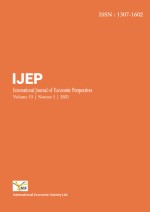Exploring the granger causal relationship between GDP growth and the ecological footprint: Evidence from Bangladesh
Keywords:
Ecological footprint, Growth, SustainabilityAbstract
This study investigates the relationship between economic growth and environmental sustainability in Bangladesh, focusing on the Granger causal dynamics between GDP growth and the ecological footprint using Vector Error Correction Models (VECM). The findings reveal that while short-term changes in the ecological footprint are largely influenced by its own past values, GDP growth, industrial output, and energy consumption exhibit limited immediate effects. In the long term, a significant negative relationship between GDP growth and the ecological footprint suggests that sustainable practices and technological advancements can mitigate environmental degradation. The absence of Granger causality between GDP growth and the ecological footprint highlights the complexity of their interaction, potentially mediated by policy and global market dynamics. The study underscores the importance of strengthening environmental governance, adopting renewable energy, and fostering international cooperation to achieve sustainable economic growth, providing evidence-based insights for policymaking in a rapidly developing economy.
References
Akturk E, Gultekin S. The impact of food production on ecological footprint in Turkey: An analysis across agriculture, livestock, and aquaculture. Environment Development and Sustainability 2024; 26(12):
Almeida D, Carvalho L, Ferreira P, Dionísio A, Haq IU. Global dynamics of environmental Kuznets Curve: A cross- correlation analysis of income and CO2 emissions. Sustainability 2024; 16(20): 1-35.
Cai J, Chen Q, Zhang Z. Balancing environmental sustainability and economic development: Perspectives from new structural economics. Sustainability 2024;16(3): 1-17.
Dardouri N, Smida M. The link between economic growth and ecological footprint: What future prospects for the G-7 countries: PMG-ARDL. Migration Letters 2023; 20 S12(2023), 50-65.
Dinda S. Environmental Kuznets Curve hypothesis: A survey. Ecological Economics 2004; 49 (2004): 431–455.
Eissa AAE. Investigating the relationship between economic growth and ecological footprint in Egypt. MSA-Management Science Journal 2003; 2(3):112-145.
Gallardo RK. The environmental impacts of agriculture: A review. International Review of Environmental and Resource Economics 2024; 18: 165-235.
Gupta M, Saini S, Sahao S. Determinants of ecological footprint and PM2.5: Role of urbanization, natural resources and technological innovation . Environmental Challenges 2022. 7(2022);1-12.
Hossin MS, Miah MA. Impact of sectoral growth on the economic development of Bangladesh: An experimental study. Research Journal of Finance and Accounting 2020; 11(14): 70-77.
Iqbal N. Economic Growth, Employment and Poverty Reduction Nexus: Evidence from Bangladesh 2012. http://dx.doi.org/10.13140/RG.2.2.30663.37288
Islam MS, Islam MM, Abubakar H. Economic growth, employment and poverty reduction nexus: Evidence from Bangladesh. Journal of International Economics 2012; 3(1): 4-18.
Islam R. The nexus of economic growth, employment and poverty reduction: An empirical analysis 2004. Discussion Paper 14.
Jiang Q, Khattak SI, Rahman ZU. Measuring the simultaneous effects of electricity consumption and production on carbon dioxide emissions (CO2e) in China: New evidence from an EKC-based assessment. Energy 2021; 229:120616
Kibria MG. Ecological footprint in Bangladesh: Identifying the intensity of economic complexity and natural resources. Heliyon 2023; 9(2023):1-11
Manik HM. Movement of the economy of Bangladesh with its sector wise contribution and growth rate. Journal of Production, Operations Management and Economics 2023; 3(2):1-8
Mehmood U, Aslam MU, Javed MA. Associating economic growth and ecological footprints through human capital and biocapacity in South Asia. World 2023; 4: 598-611.
Metcalfe I. Environmental concerns for Bangladesh. Journal of South Asian Studies 2003; XXV1(3): 423-438.
Nath NC. Manufacturing sector of Bangladesh-growth, structure and strategies for future development. Bangladesh Journal of Political Economy 2014; 3(1):189-236
Oprea SV, Bara A, Georgescu IA. Assessing the dynamics of ecological footprint in relation to economic and energy factors: A comparative analysis of Finland and Japan. Journal of the Knowledge Economy 2024.;
Rahman M, Chowdhury S, Zayed MN, Imran MA, Hanzhurenko I, Nitsenko V.. Does globalization trigger an ecological footprint? A time series analysis of Bangladesh. Rocznik Ochrona Środowiska 2022; 24(2022): 141-162
Rahman SH. Economic growth, poverty and inequality revisited. BIGD Working Paper 2015, No. 26
Raihan A, Muhtasim DA, Khan MNA, Pavel MI, Faruk O. Nexus between carbon emissions, economic growth, renewable energy use, urbanization, industrialization, technological innovation, and forest area towards achieving environmental sustainability in Bangladesh. Clean Energy System 2022; 3(2022):1-14
Raihan S, Bourguignon F. Chapter 2: Bangladesh’s Development: Achievements and Challenges. WP20/BDID[02]. Bangladesh Institutional DiagnosticI
Sarwar S, Alsaggaf MI, Tingqiu C. Nexus among economic growth, education, health, and environment: Dynamic analysis of world-level data. Frontiers in Public Health 2019; 7: 1-16.
Touitou M. Empirical analysis of the environmental Kuznets curve for economic growth and CO2 emissions in North African countries. Econometrics 2021. Advances in Ap- plied Data Analysis; 25(2): 67-77.
Utomo B, Riatmaja DS, Aninam J, Wahyudi FS. Environmental sustainability and economic growth: Policy implications for developing countries. Nomico Journal 2024; 1(5):87-93.
Xu X, Nadeem M, Niazi M. The impact of the agricultural system on the environmental footprints: New insights from contemporary Chinese Agricultural Perspectives 2024; 33(5):5943-5952
Published
How to Cite
Issue
Section
Copyright (c) 2025 Tonmoy Chowdhury, Ratan Chowdhury, Ruhul Kuddus Chowdhury

This work is licensed under a Creative Commons Attribution 4.0 International License.
Allows users to: distribute and copy the article; create extracts, abstracts, and other revised versions, adaptations or derivative works of or from an article (such as a translation); include in a collective work (such as an anthology); and text or data mine the article. These uses are permitted even for commercial purposes, provided the user: gives appropriate credit to the author(s) (with a link to the formal publication through the relevant URL ID); includes a link to the license; indicates if changes were made; and does not represent the author(s) as endorsing the adaptation of the article or modify the article in such a way as to damage the authors' honor or reputation. CC BY








